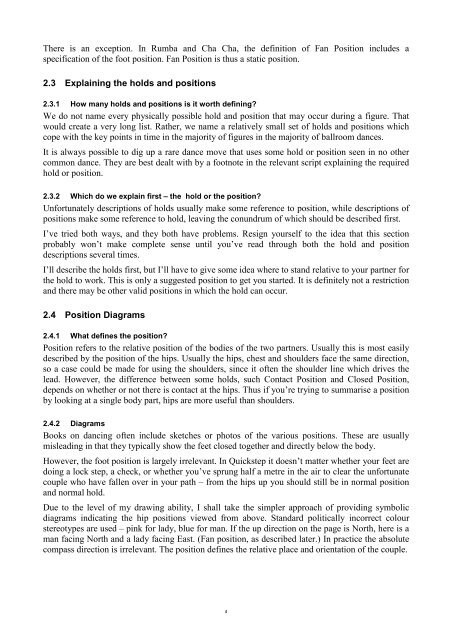Reading Ballroom Dance Scripts - Dance - Plussed.net
Reading Ballroom Dance Scripts - Dance - Plussed.net
Reading Ballroom Dance Scripts - Dance - Plussed.net
You also want an ePaper? Increase the reach of your titles
YUMPU automatically turns print PDFs into web optimized ePapers that Google loves.
There is an exception. In Rumba and Cha Cha, the definition of Fan Position includes a<br />
specification of the foot position. Fan Position is thus a static position.<br />
2.3 Explaining the holds and positions<br />
2.3.1 How many holds and positions is it worth defining?<br />
We do not name every physically possible hold and position that may occur during a figure. That<br />
would create a very long list. Rather, we name a relatively small set of holds and positions which<br />
cope with the key points in time in the majority of figures in the majority of ballroom dances.<br />
It is always possible to dig up a rare dance move that uses some hold or position seen in no other<br />
common dance. They are best dealt with by a footnote in the relevant script explaining the required<br />
hold or position.<br />
2.3.2 Which do we explain first – the hold or the position?<br />
Unfortunately descriptions of holds usually make some reference to position, while descriptions of<br />
positions make some reference to hold, leaving the conundrum of which should be described first.<br />
I’ve tried both ways, and they both have problems. Resign yourself to the idea that this section<br />
probably won’t make complete sense until you’ve read through both the hold and position<br />
descriptions several times.<br />
I’ll describe the holds first, but I’ll have to give some idea where to stand relative to your partner for<br />
the hold to work. This is only a suggested position to get you started. It is definitely not a restriction<br />
and there may be other valid positions in which the hold can occur.<br />
2.4 Position Diagrams<br />
2.4.1 What defines the position?<br />
Position refers to the relative position of the bodies of the two partners. Usually this is most easily<br />
described by the position of the hips. Usually the hips, chest and shoulders face the same direction,<br />
so a case could be made for using the shoulders, since it often the shoulder line which drives the<br />
lead. However, the difference between some holds, such Contact Position and Closed Position,<br />
depends on whether or not there is contact at the hips. Thus if you’re trying to summarise a position<br />
by looking at a single body part, hips are more useful than shoulders.<br />
2.4.2 Diagrams<br />
Books on dancing often include sketches or photos of the various positions. These are usually<br />
misleading in that they typically show the feet closed together and directly below the body.<br />
However, the foot position is largely irrelevant. In Quickstep it doesn’t matter whether your feet are<br />
doing a lock step, a check, or whether you’ve sprung half a metre in the air to clear the unfortunate<br />
couple who have fallen over in your path – from the hips up you should still be in normal position<br />
and normal hold.<br />
Due to the level of my drawing ability, I shall take the simpler approach of providing symbolic<br />
diagrams indicating the hip positions viewed from above. Standard politically incorrect colour<br />
stereotypes are used – pink for lady, blue for man. If the up direction on the page is North, here is a<br />
man facing North and a lady facing East. (Fan position, as described later.) In practice the absolute<br />
compass direction is irrelevant. The position defines the relative place and orientation of the couple.<br />
4


